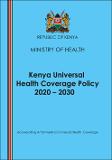| dc.date.accessioned | 2021-04-20T12:07:33Z | |
| dc.date.available | 2021-04-20T12:07:33Z | |
| dc.date.issued | 2004 | |
| dc.identifier.uri | http://repository.kippra.or.ke/handle/123456789/2863 | |
| dc.description.abstract | Since independence in 1963, Kenya has continued to design and implement policies
aimed at promoting coverage of and access to modern healthcare in an attempt to
attain the long-term objectives of health for all. On attaining independence, the
Government committed itself to providing "free" health services as part of its
development strategy to alleviate poverty and improve the welfare and productivity
of the nation. The development and expansion of health services and facilities in
tenns of spatial coverage, training of personnel, and in tertiary healthcare delivery
services since independence has been commendable. Though the physical
infrastructure for health provision in Kenya has expanded rapidly, distribution
and coverage remains uneven especially in rural areas. Maintenance of public sector
health facilities has been a big problem and a major burden for the Ministry; of
Health. Healthcare policy reforms have therefore been adopted as a strategy of
supplementing government budgets to revitalize healthcare delivery systems. | en |
| dc.language.iso | en | en |
| dc.publisher | The Kenya Institute for Public Policy Research and Analysis (KIPPRA) | en |
| dc.relation.ispartofseries | WP/11/2004; | |
| dc.subject | Health indicators | en |
| dc.subject | Health system | en |
| dc.subject | Health quality | en |
| dc.subject | Health decentralization | en |
| dc.subject | Health policies | en |
| dc.title | Working Paper No. 11 of 2004 on a Review of the Health Sector in Kenya | en |
| dc.type | KIPPRA Publications | en |
| ppr.contributor.author | Kimalu, Paul K. ; Nafula, Nancy N. ; Manda, Damiano K. ; Bedi, Arjun ; Mwabu, Germano & Kimenyi, Mwangi S. | |




